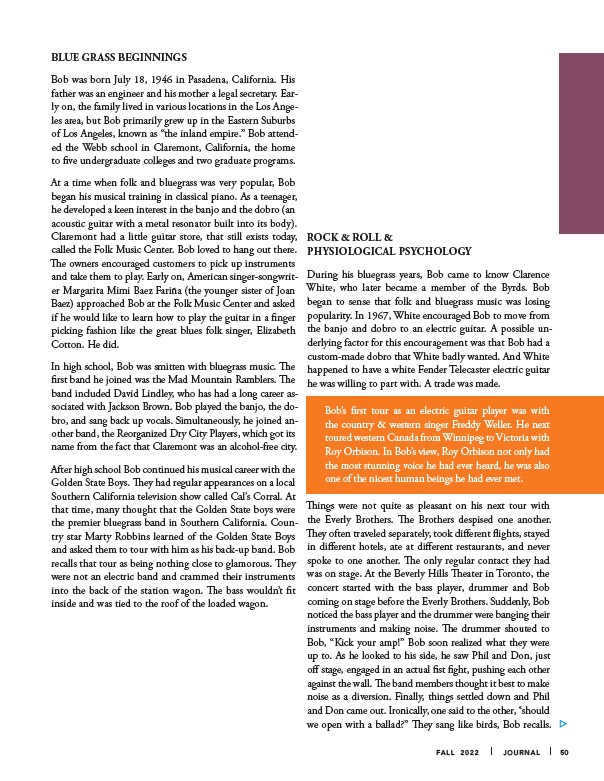
BLUE GRASS BEGINNINGS
Bob was born July 18, 1946 in Pasadena, California. His
father was an engineer and his mother a legal secretary. Early
on, the family lived in various locations in the Los Angeles
area, but Bob primarily grew up in the Eastern Suburbs
of Los Angeles, known as “the inland empire.” Bob attended
the Webb school in Claremont, California, the home
to five undergraduate colleges and two graduate programs.
At a time when folk and bluegrass was very popular, Bob
began his musical training in classical piano. As a teenager,
he developed a keen interest in the banjo and the dobro (an
acoustic guitar with a metal resonator built into its body).
Claremont had a little guitar store, that still exists today,
called the Folk Music Center. Bob loved to hang out there.
The owners encouraged customers to pick up instruments
and take them to play. Early on, American singer-songwriter
Margarita Mimi Baez Fariña (the younger sister of Joan
Baez) approached Bob at the Folk Music Center and asked
if he would like to learn how to play the guitar in a finger
picking fashion like the great blues folk singer, Elizabeth
Cotton. He did.
In high school, Bob was smitten with bluegrass music. The
first band he joined was the Mad Mountain Ramblers. The
band included David Lindley, who has had a long career associated
with Jackson Brown. Bob played the banjo, the dobro,
and sang back up vocals. Simultaneously, he joined another
band, the Reorganized Dry City Players, which got its
name from the fact that Claremont was an alcohol-free city.
After high school Bob continued his musical career with the
Golden State Boys. They had regular appearances on a local
Southern California television show called Cal’s Corral. At
that time, many thought that the Golden State boys were
the premier bluegrass band in Southern California. Country
star Marty Robbins learned of the Golden State Boys
and asked them to tour with him as his back-up band. Bob
recalls that tour as being nothing close to glamorous. They
were not an electric band and crammed their instruments
into the back of the station wagon. The bass wouldn’t fit
inside and was tied to the roof of the loaded wagon.
ROCK & ROLL &
PHYSIOLOGICAL PSYCHOLOGY
During his bluegrass years, Bob came to know Clarence
White, who later became a member of the Byrds. Bob
began to sense that folk and bluegrass music was losing
popularity. In 1967, White encouraged Bob to move from
the banjo and dobro to an electric guitar. A possible underlying
factor for this encouragement was that Bob had a
custom-made dobro that White badly wanted. And White
happened to have a white Fender Telecaster electric guitar
he was willing to part with. A trade was made.
Bob’s first tour as an electric guitar player was with
the country & western singer Freddy Weller. He next
toured western Canada from Winnipeg to Victoria with
Roy Orbison. In Bob’s view, Roy Orbison not only had
the most stunning voice he had ever heard, he was also
one of the nicest human beings he had ever met.
Things were not quite as pleasant on his next tour with
the Everly Brothers. The Brothers despised one another.
They often traveled separately, took different flights, stayed
in different hotels, ate at different restaurants, and never
spoke to one another. The only regular contact they had
was on stage. At the Beverly Hills Theater in Toronto, the
concert started with the bass player, drummer and Bob
coming on stage before the Everly Brothers. Suddenly, Bob
noticed the bass player and the drummer were banging their
instruments and making noise. The drummer shouted to
Bob, “Kick your amp!” Bob soon realized what they were
up to. As he looked to his side, he saw Phil and Don, just
off stage, engaged in an actual fist fight, pushing each other
against the wall. The band members thought it best to make
noise as a diversion. Finally, things settled down and Phil
and Don came out. Ironically, one said to the other, “should
we open with a ballad?” They sang like birds, Bob recalls.
FALL 2022 JOURNAL 50